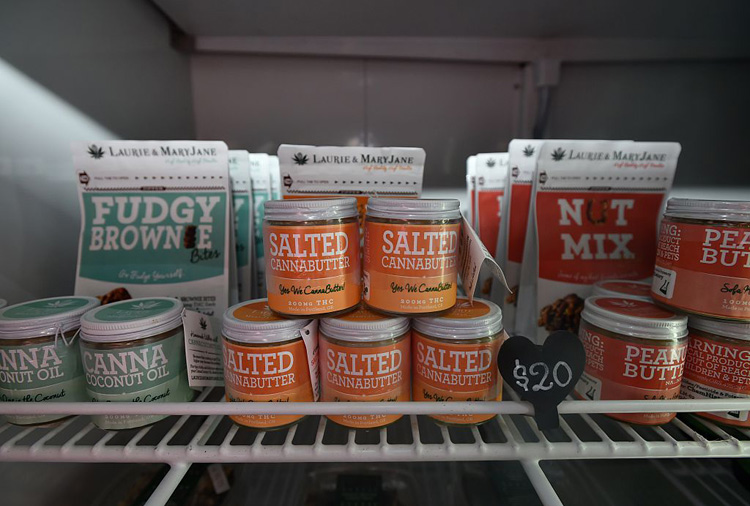In 2014, Colorado became the first U.S. state to implement full legal sales of marijuana.

It had never been done before, and there were bound to be some surprises.
One was that, despite the decades of associating pot use with the haze and skunky smell of a joint, nearly half the marijuana sold wasn’t designed to be smoked, but ingested — eaten or drunk.
It makes sense on one level — fewer and fewer people want to smoke tobacco, so why would they want to smoke marijuana when they could consume it some other way? THC can be packaged into anything from tea to lollipops.
“I don’t even know anybody who smokes any more. Not marijuana — I mean cigarettes,” says Bruce Linton, CEO of Canopy Growth, a large medical marijuana growing facility in Smiths Falls, Ont., which plans to produce recreational pot after legalization. “So the probability that they’re going to start smoking marijuana is low.”
READ: Alberta justice minister heading to Colorado to research marijuana policies
Is that a good thing? In a way, yes, since it removes the problems connected to smoking. (Research shows that if smoked marijuana is a gateway drug to anything, it’s tobacco.
WATCH: Public Safety Minister Ralph Goodale discusses the federal government panel of health, policy, and law enforcement experts who will help establish the federal government’s legal framework for marijuana legalization.

READ: Pot legalization may roll back progress on tobacco, expert fears
But it turns out that there are potential dangers with innocent-looking edibles.
Children
One is, precisely, that they often look innocent. With 2.8 million marijuana edibles sold in a year in Colorado, many packaged as some form of candy — cotton candy, chocolate taffy, sour candies — it’s not surprising that some finds its way to children.
Admissions to Colorado’s children’s hospital for marijuana exposure roughly doubled after legalization; about half of the cases involved edibles.
A federal discussion paper obtained by The Canadian Press earlier this year under access-to-information laws flagged dangers to children as a specific concern.
This month, new rules in Colorado require standardized symbols (! THC) on edibles, along with banning the word “candy” or “candies” on packaging. In June, lawmakers banned candy edibles “in the shape of an animal, fruit or character,” though other shapes are fine.
READ: ‘It’s a wild ride’: Colorado, Alaska officials offer advice to Trudeau on legalizing pot
Linton strongly opposes packaging edibles in a form that’s likely to appeal to children:
“When I was in Colorado, I would see the lollipops that have swirls all the way through, and it comes like a pinwheel out from the centre. How much is in there? How much of the lollipop should you eat? And why does it look like any adult walking around with it stole it from a child?”
“Canada, I hope, and I’m reasonably certain, is not going there.”
Overdoing dosages
Colorado’s experience also shows that people can consume the equivalent of far more cannabis, through edibles, than they meant to. After legalization, New York Times columnist Maureen Dowd ate an amount of THC-laced candy intended for 16 people (information, she wrote, that wasn’t on the label).
“I strained to remember where I was or even what I was wearing, touching my green corduroy jeans and staring at the exposed-brick wall,” she wrote. “As my paranoia deepened, I became convinced that I had died and no one was telling me. It took all night before it began to wear off, distressingly slowly.”
READ: Candy at birthday party that sent 19 to hospital likely edible marijuana
Shortly after legalization, a Wyoming teenager in Colorado jumped to his death from a hotel balcony after eating a cookie with marijuana intended for six people. The clerk who sold it to him told him this, according to a police report, but the 19-year-old didn’t seem to realize that he had to wait for a while for the piece of cookie he’d eaten to take effect, and impatiently ate the rest.
(In fairness, deaths linked to marijuana are extremely rare.)
WATCH: Police across the country are getting ready for the legalization of marijuana, which is expected to happen in spring 2017. David Baxter spoke with police about how they plan on handling drivers incluenced by marijuana, and got a first hand look at one of their current detection methods.

Compounding the problem, Colorado officials found that edibles were most attractive to the least experienced users, those who only started experimenting with pot after legalization.
Digestion
The delay in feeling intoxication from edibles can lead people into impaired driving, warns Robert Mann of the Centre for Addiction and Mental Health in Toronto:
“You can inadvertently consume a much larger dose than what you might normally get when you smoke. That creates all kinds of concerns about what the impact will be on driving.”
“When the change of the level of a drug in your system is fastest, that’s when you notice it the most. When it’s slower, you notice it less, even though the change may still be occurring.”
Linton would like to see edibles sold to the recreational market in Canada to take a very austere form:
“A hard, edible good which would be very generic and simple and unflavoured, so that there would be no strawberry flavour, or anything of that nature, but would be very specifically a quantity that one candy, or one lozenge, one element, will equal x milligrams at y.”
Legalization of recreational pot should go with an educational program relating a given amount of THC to the rough equivalent of alcohol, since that’s already widely understood, Linton says.



Comments